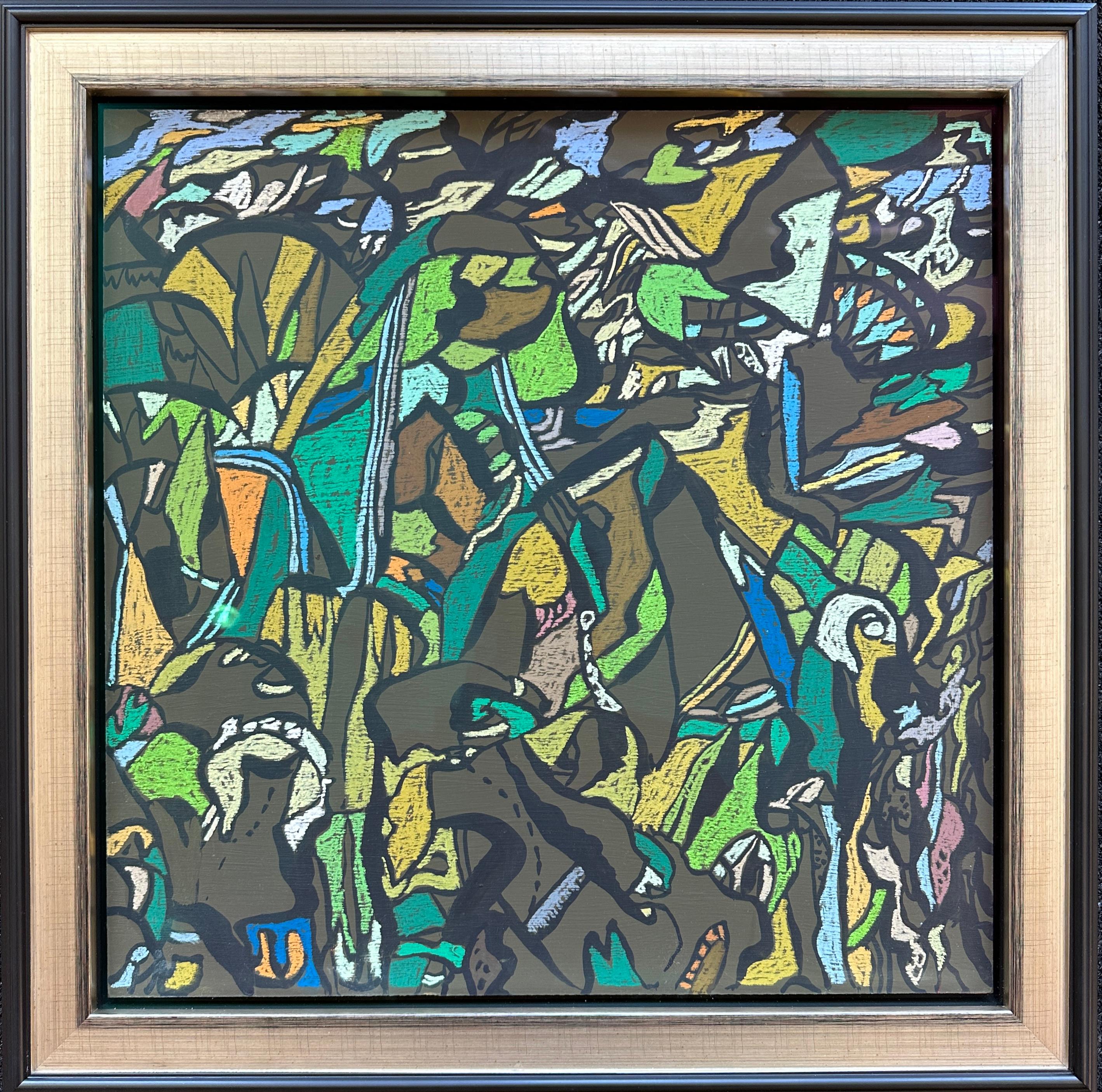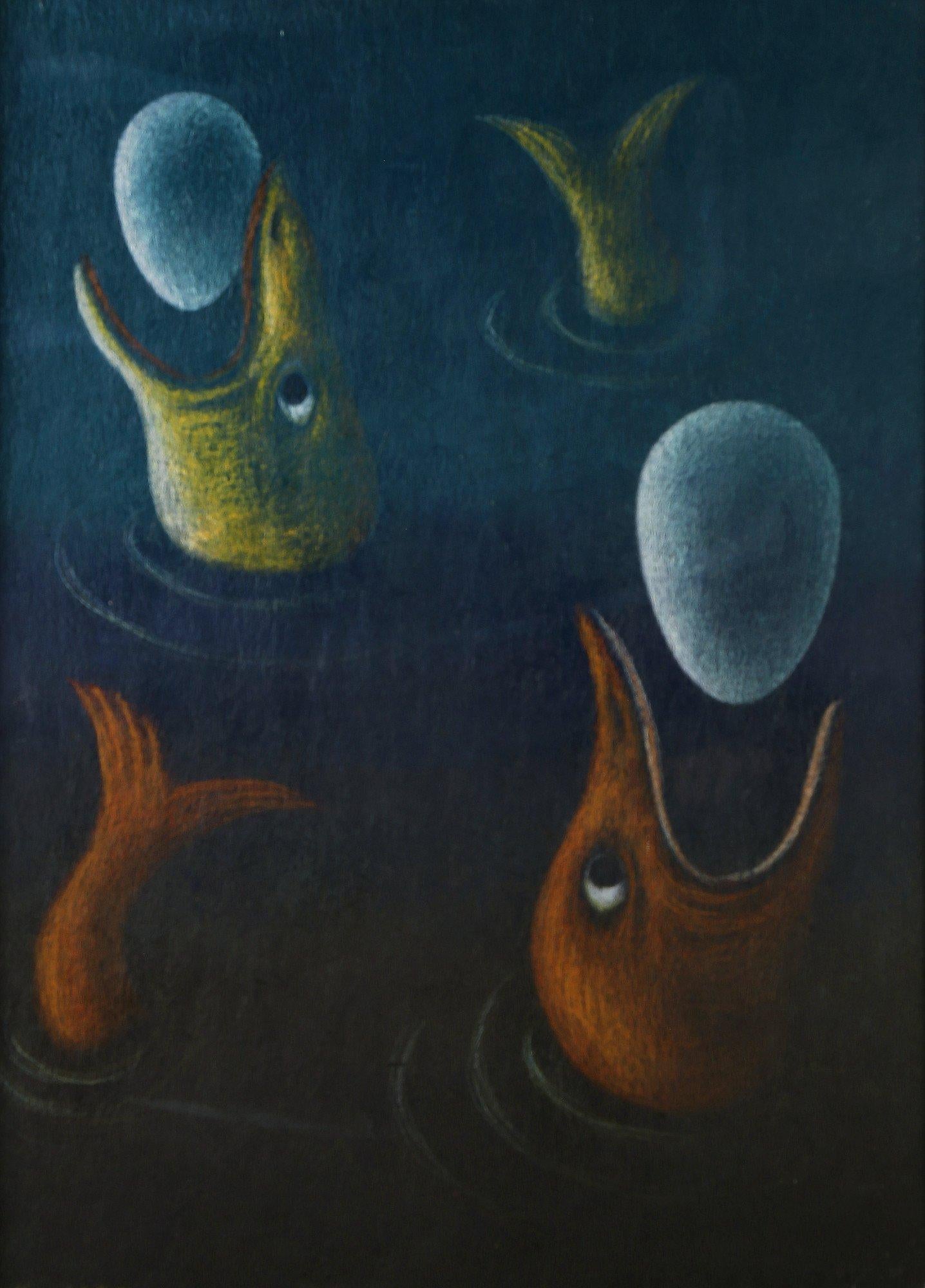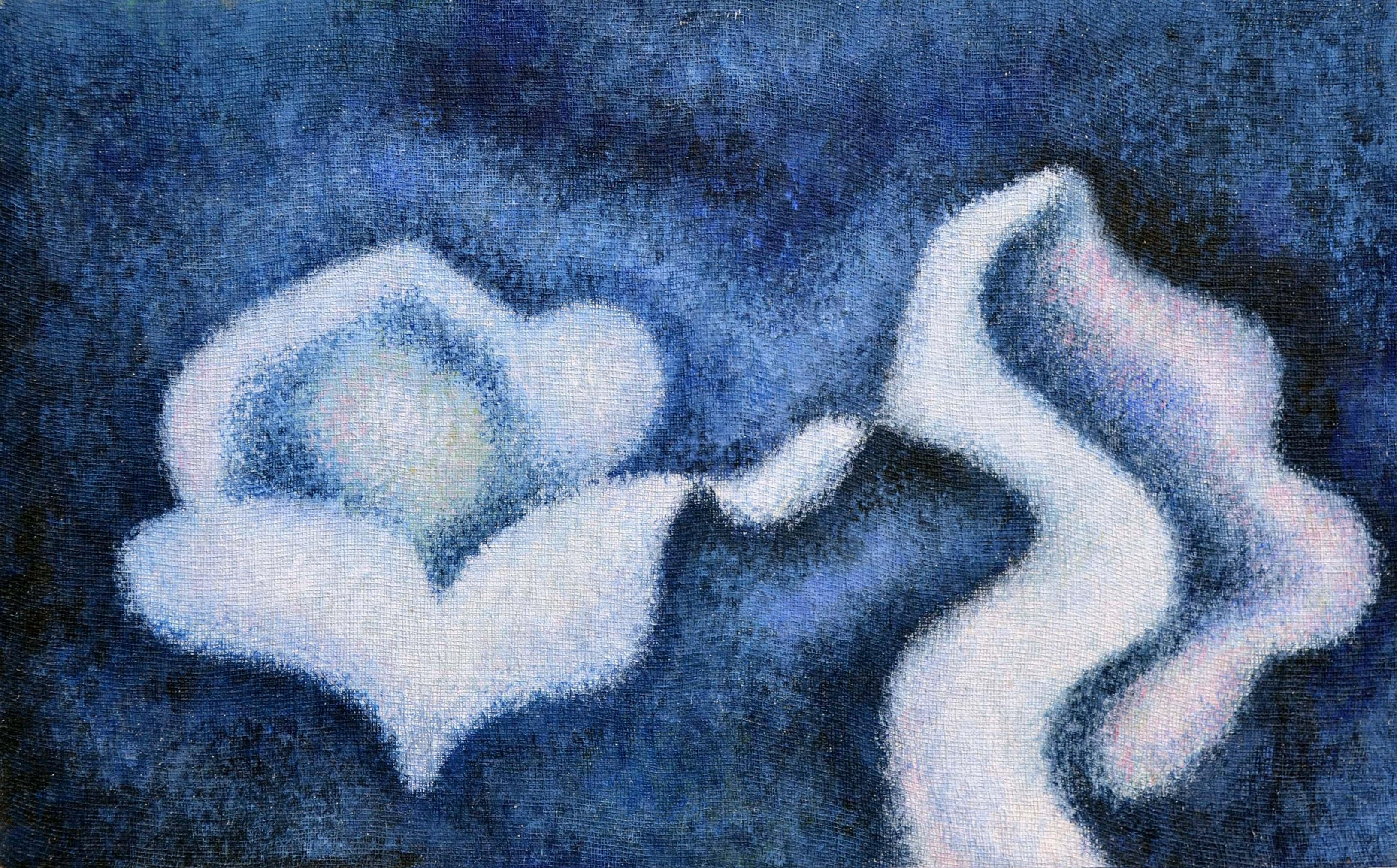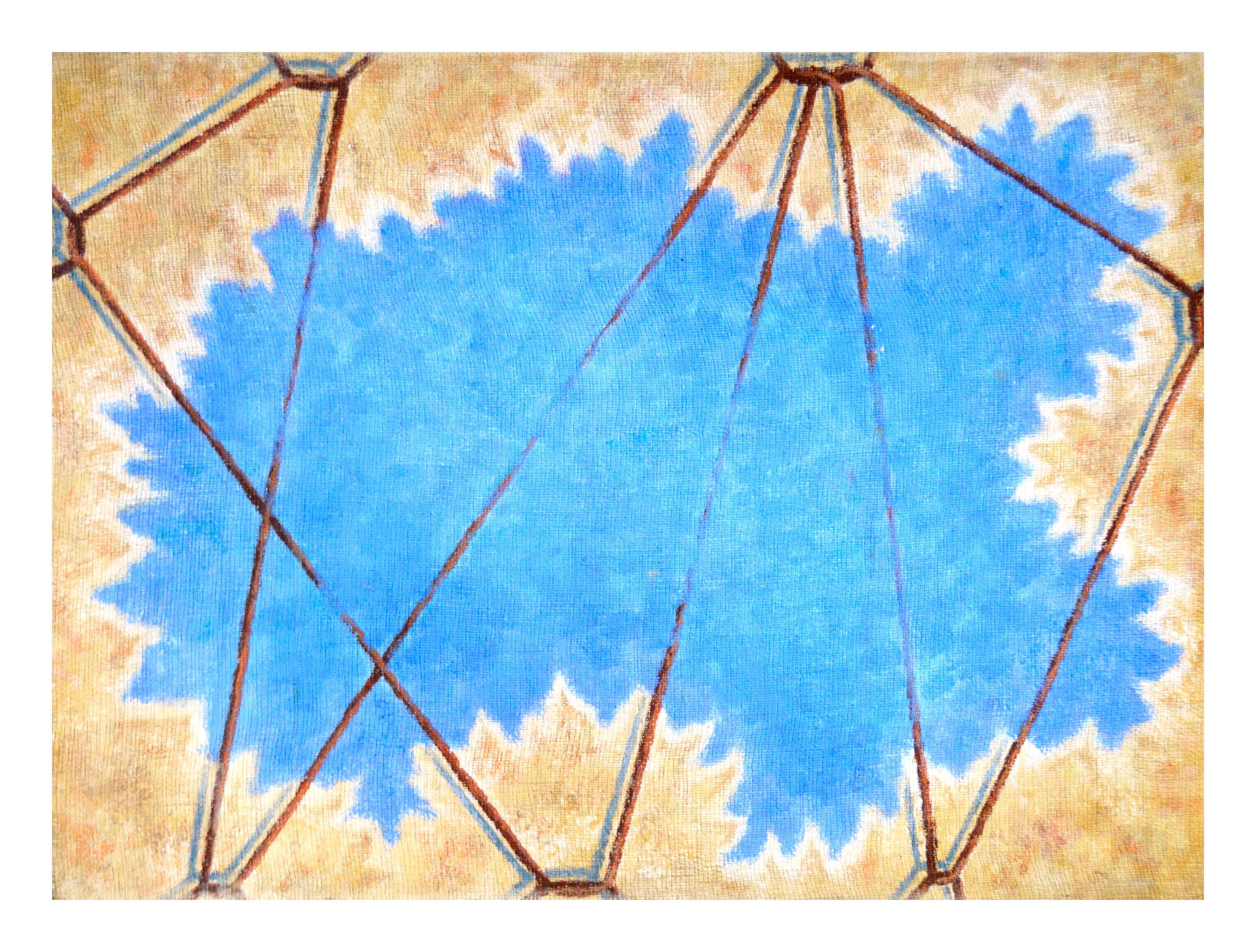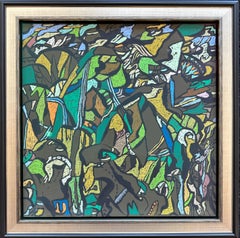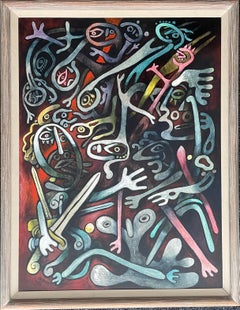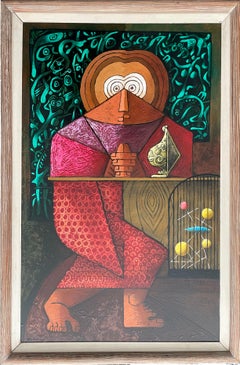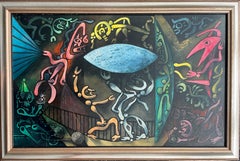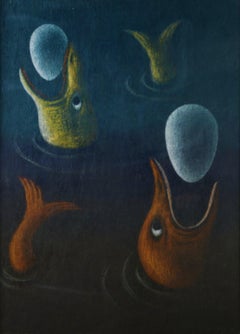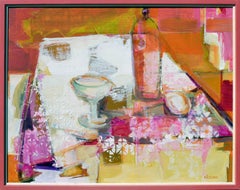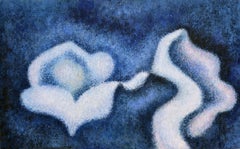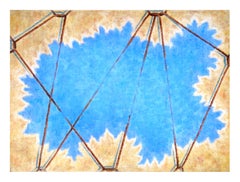Items Similar to Untitled-006 abstract painting by Fred Martin
Want more images or videos?
Request additional images or videos from the seller
1 of 11
Fred MartinUntitled-006 abstract painting by Fred Martin1970
1970
About the Item
Exhibited:
2003 Oakland Museum of California "Fred Martin Retrospective"
A native Californian, Fred Martin was born in San Francisco in 1927, and received both his BA (1949) and MA (1954) from University of California, Berkley. At the San Francisco Art Institute Martin studied with Clyfford Still, Mark Rothko and David Park. After receiving his masters degree Martin became the Director of Exhibitions at the SFAI, and thus began a life-long relationship with the Institute. He held multiple positions including Director of the College at the San Francisco Art Institute until 1975, and from 1983-92 Dean of Academic Affairs.
Martin's works were influenced by his varied and wide-ranging interests. According to one of his students, "[He] is a pure believer in the importance of art as a spiritual activity." Many of Martin's paintings may be found in museums including MoMA, the Whitney, Los Angeles County Museum of Art, San Francisco Museum of Modern Art, as well as other museums and private collections.
The framed dimensions are 51" x 27" x 3" This work was reviewed by the artist is signed verso.
- Creator:Fred Martin (1927, American)
- Creation Year:1970
- Dimensions:Height: 48 in (121.92 cm)Width: 24 in (60.96 cm)
- Medium:
- Movement & Style:
- Period:
- Condition:The artist personally inspected and then signed this work when he visited our gallery in 2015.
- Gallery Location:Hudson, NY
- Reference Number:Seller: MaFr0061stDibs: LU2465212173782
About the Seller
5.0
Vetted Professional Seller
Every seller passes strict standards for authenticity and reliability
Established in 1973
1stDibs seller since 2023
10 sales on 1stDibs
- ShippingRetrieving quote...Shipping from: Hudson, NY
- Return Policy
Authenticity Guarantee
In the unlikely event there’s an issue with an item’s authenticity, contact us within 1 year for a full refund. DetailsMoney-Back Guarantee
If your item is not as described, is damaged in transit, or does not arrive, contact us within 7 days for a full refund. Details24-Hour Cancellation
You have a 24-hour grace period in which to reconsider your purchase, with no questions asked.Vetted Professional Sellers
Our world-class sellers must adhere to strict standards for service and quality, maintaining the integrity of our listings.Price-Match Guarantee
If you find that a seller listed the same item for a lower price elsewhere, we’ll match it.Trusted Global Delivery
Our best-in-class carrier network provides specialized shipping options worldwide, including custom delivery.More From This Seller
View AllSpring Landscape acrylic and pastel painting by Fred Martin
By Fred Martin
Located in Hudson, NY
Exhibited:
1973 San Francisco Museum of Art
2003 Oakland Museum of California "Fred Martin Retrospective"
A native Californian, Fred Martin was born...
Category
1970s American Modern Abstract Paintings
Materials
Masonite, Pastel, Acrylic
The Magician oil and tempera painting by Julio de Diego
By Julio de Diego
Located in Hudson, NY
Julio De Diego’s Atomic Series paintings made an extraordinary statement regarding the shock and fear that accompanied the dawn of the nuclear age. In the artist’s own words, “Scientists were working secretly to develop formidable powers taken from the mysterious depths of the earth - with the power to make the earth useless! Then, the EXPLOSION! . . . we entered the Atomic Age, and from there the neo-Atomic war begins. Explosions fell everywhere and man kept on fighting, discovering he could fight without flesh.”
To execute these works, De Diego developed a technique of using tempera underpainting before applying layer upon layer of pigmented oil glazes. The result is paintings with surfaces which were described as “bonelike” in quality. The forms seem to float freely, creating a three-dimensional visual effect. In the 1954 book The Modern Renaissance in American Art, author Ralph Pearson summarizes the series as “a fantastic interpretation of a weighty theme. Perhaps it is well to let fantasy and irony appear to lighten the devastating impact. By inverse action, they may in fact increase its weight.”
Exhibited
1964 Marion Koogler McNay Art Institute, San Antonio, Texas
This work retains its original frame which measures 54" x 42" x 2"
About this artist: Julio De Diego crafted a formidable persona within the artistic developments and political struggles of his time. The artist characterized his own work as “lyrical,” explaining, “through the years, the surrealists, the social-conscious painters and the others tried to adopt me, but I went my own way, good, bad or indifferent.” [1] His independence manifested early in life when de Diego left his parent’s home in Madrid, Spain, in adolescence following his father’s attempts to curtail his artistic aspirations. At the age of fifteen he held his first exhibition, set up within a gambling casino. He managed to acquire an apprenticeship in a studio producing scenery for Madrid’s operas, but moved from behind the curtains to the stage, trying his hand at acting and performing as an extra in the Ballet Russes’ Petrouchka with Nijinsky. He spent several years in the Spanish army, including a six-month stretch in the Rif War of 1920 in Northern Africa. His artistic career pushed ahead as he set off for Paris and became familiar with modernism’s forays into abstraction, surrealism, and cubism.
The artist arrived in the U.S. in 1924 and settled in Chicago two years later. He established himself with a commission for the decoration of two chapels in St. Gregory’s Church. He also worked in fashion illustration, designed magazine covers and developed a popular laundry bag for the Hotel Sherman. De Diego began exhibiting through the Art Institute of Chicago in 1929, and participated in the annual Chicago Artists Exhibitions, Annual American Exhibitions, and International Water Color Exhibitions. He held a solo exhibition at the Art Institute of Chicago in the summer of 1935. Though the artist’s career was advancing, his family life had deteriorated. In 1932 his first marriage dissolved, and the couple’s young daughter Kiriki was sent to live with friend Paul Hoffman.
De Diego continued to develop his artistic vocabulary with a growing interest in Mexican art. He traveled throughout the country acquainting himself with the works of muralists such as Carlos Merida, and also began a collection of small native artifacts...
Category
1940s American Modern Abstract Paintings
Materials
Masonite, Oil, Tempera
St. Atomic oil and tempera painting by Julio de Diego
By Julio de Diego
Located in Hudson, NY
Julio De Diego’s Atomic Series paintings made an extraordinary statement regarding the shock and fear that accompanied the dawn of the nuclear age. In the artist’s own words, “Scientists were working secretly to develop formidable powers taken from the mysterious depths of the earth - with the power to make the earth useless! Then, the EXPLOSION! . . . we entered the Atomic Age, and from there the neo-Atomic war begins. Explosions fell everywhere and man kept on fighting, discovering he could fight without flesh.”
To execute these works, De Diego developed a technique of using tempera underpainting before applying layer upon layer of pigmented oil glazes. The result is paintings with surfaces which were described as “bonelike” in quality. The forms seem to float freely, creating a three-dimensional visual effect. In the 1954 book The Modern Renaissance in American Art, author Ralph Pearson summarizes the series as “a fantastic interpretation of a weighty theme. Perhaps it is well to let fantasy and irony appear to lighten the devastating impact. By inverse action, they may in fact increase its weight.”
Exhibited
1950 University of Illinois at Urbana "Contemporary American Painting"
1964 Marion Koogler McNay Art Institute, San Antonio, Texas
This work retains its original frame which measures 54" x 36" x 2".
About this artist: Julio De Diego crafted a formidable persona within the artistic developments and political struggles of his time. The artist characterized his own work as “lyrical,” explaining, “through the years, the surrealists, the social-conscious painters and the others tried to adopt me, but I went my own way, good, bad or indifferent.” [1] His independence manifested early in life when de Diego left his parent’s home in Madrid, Spain, in adolescence following his father’s attempts to curtail his artistic aspirations. At the age of fifteen he held his first exhibition, set up within a gambling casino. He managed to acquire an apprenticeship in a studio producing scenery for Madrid’s operas, but moved from behind the curtains to the stage, trying his hand at acting and performing as an extra in the Ballet Russes’ Petrouchka with Nijinsky. He spent several years in the Spanish army, including a six-month stretch in the Rif War of 1920 in Northern Africa. His artistic career pushed ahead as he set off for Paris and became familiar with modernism’s forays into abstraction, surrealism, and cubism.
The artist arrived in the U.S. in 1924 and settled in Chicago two years later. He established himself with a commission for the decoration of two chapels in St. Gregory’s Church. He also worked in fashion illustration, designed magazine covers and developed a popular laundry bag for the Hotel Sherman. De Diego began exhibiting through the Art Institute of Chicago in 1929, and participated in the annual Chicago Artists Exhibitions, Annual American Exhibitions, and International Water Color Exhibitions. He held a solo exhibition at the Art Institute of Chicago in the summer of 1935. Though the artist’s career was advancing, his family life had deteriorated. In 1932 his first marriage dissolved, and the couple’s young daughter Kiriki was sent to live with friend Paul Hoffman.
De Diego continued to develop his artistic vocabulary with a growing interest in Mexican art. He traveled throughout the country acquainting himself with the works of muralists such as Carlos Merida, and also began a collection of small native artifacts...
Category
1940s American Modern Abstract Paintings
Materials
Masonite, Oil, Tempera
Inevitable Day – Birth of the Atom oil and tempera painting by Julio De Diego
By Julio de Diego
Located in Hudson, NY
Julio De Diego’s Atomic Series paintings made an extraordinary statement regarding the shock and fear that accompanied the dawn of the nuclear age. In the artist’s own words, “Scientists were working secretly to develop formidable powers taken from the mysterious depths of the earth - with the power to make the earth useless! Then, the EXPLOSION! . . . we entered the Atomic Age, and from there the neo-Atomic war begins. Explosions fell everywhere and man kept on fighting, discovering he could fight without flesh.”
To execute these works, De Diego developed a technique of using tempera underpainting before applying layer upon layer of pigmented oil glazes. The result is paintings with surfaces which were described as “bonelike” in quality. The forms seem to float freely, creating a three-dimensional visual effect. In the 1954 book The Modern Renaissance in American Art, author Ralph Pearson summarizes the series as “a fantastic interpretation of a weighty theme. Perhaps it is well to let fantasy and irony appear to lighten the devastating impact. By inverse action, they may in fact increase its weight.”
Bibliography
Art in America, April 1951, p.78
About this artists: Julio De Diego crafted a formidable persona within the artistic developments and political struggles of his time. The artist characterized his own work as “lyrical,” explaining, “through the years, the surrealists, the social-conscious painters and the others tried to adopt me, but I went my own way, good, bad or indifferent.” [1] His independence manifested early in life when de Diego left his parent’s home in Madrid, Spain, in adolescence following his father’s attempts to curtail his artistic aspirations. At the age of fifteen he held his first exhibition, set up within a gambling casino. He managed to acquire an apprenticeship in a studio producing scenery for Madrid’s operas, but moved from behind the curtains to the stage, trying his hand at acting and performing as an extra in the Ballet Russes’ Petrouchka with Nijinsky. He spent several years in the Spanish army, including a six-month stretch in the Rif War of 1920 in Northern Africa. His artistic career pushed ahead as he set off for Paris and became familiar with modernism’s forays into abstraction, surrealism, and cubism.
The artist arrived in the U.S. in 1924 and settled in Chicago two years later. He established himself with a commission for the decoration of two chapels in St. Gregory’s Church. He also worked in fashion illustration, designed magazine covers and developed a popular laundry bag for the Hotel Sherman. De Diego began exhibiting through the Art Institute of Chicago in 1929, and participated in the annual Chicago Artists Exhibitions, Annual American Exhibitions, and International Water Color Exhibitions. He held a solo exhibition at the Art Institute of Chicago in the summer of 1935. Though the artist’s career was advancing, his family life had deteriorated. In 1932 his first marriage dissolved, and the couple’s young daughter Kiriki was sent to live with friend Paul Hoffman.
De Diego continued to develop his artistic vocabulary with a growing interest in Mexican art. He traveled throughout the country acquainting himself with the works of muralists such as Carlos Merida, and also began a collection of small native artifacts...
Category
1940s American Modern Abstract Paintings
Materials
Masonite, Oil, Tempera
Ceremonial Dancers oil and tempera painting by Julio De Diego
By Julio de Diego
Located in Hudson, NY
Artwork measures 48" x 30" and framed 56 ¼" x 38 ¼" x 3"
Provenance:
John Heller Gallery, NYC, circa 1975 (label verso)
The artist's daughter
Corbino Galleries, Sarasota, FL (1990)...
Category
1940s Modern Abstract Paintings
Materials
Masonite, Oil, Tempera
Series 67 No.4 abstract oil painting by Jack Wolsky
Located in Hudson, NY
Series 67, No. 4 (1955)
Oil on masonite
48" x 24 ½"
49" x 25 ¼" x 1 ¾" framed
About this artist: Jack Wolsky was born in 1930 in Rochester, New York.
He taught in the Department o...
Category
1950s Abstract Abstract Paintings
Materials
Masonite, Oil
You May Also Like
Chimeras, mid-century figural abstract blue acrylic painting
By Clarence Holbrook Carter
Located in Beachwood, OH
Chimeras, 1974
Acrylic and pastel on textured paper
Mid-century figural abstract blue acrylic painting
Clarence Holbrook Carter achieved a level of national artistic success that w...
Category
1970s American Modern Figurative Paintings
Materials
Pastel, Acrylic
Mid-Century Modern Abstracted Cubist Table Still-Life in Acrylic on Masonite
Located in Soquel, CA
Mid-Century Modern Abstracted Cubist Table Still-Life in Acrylic on Masonite
Vibrant mid-century modern still life with abstracted synthetic cubist elements in warm colors, highligh...
Category
1970s American Modern Still-life Paintings
Materials
Masonite, Acrylic
Modern Abstract Blue Rose, Vintage Abstracted Minimalist Floral by Eleanor Perry
By Eleanor Perry
Located in Soquel, CA
Modern Abstract Blue Rose, Vintage Abstracted Minimalist Floral by Eleanor Perry
Modernist blue and white rose abstract by San Francisco, California artist Eleanor Louise Perry (Ame...
Category
1970s American Modern Abstract Paintings
Materials
Canvas, Masonite, Acrylic
Patch of Cyan, Vintage Electric Blue Geometric Abstract by Eleanor Perry
By Eleanor Perry
Located in Soquel, CA
Patch of Cyan, Vintage Electric Blue Geometric Abstract by Eleanor Perry
A bold modernist abstract painting by San Francisco, California artist Eleanor Perry (American, 20th Centu...
Category
1970s American Modern Abstract Paintings
Materials
Masonite, Acrylic
Abstracted Figure in Nature in Ink and Pastel on Paper
By Frank Rowland
Located in Soquel, CA
Abstracted Figure in Nature in Ink and Pastel on Paper
Beautiful and unique abstract piece of a figure in nature by Frank Rowland (American, 1927-2012). The graceful and simplifie...
Category
1970s American Modern Figurative Paintings
Materials
Paper, Pastel, Ink
Entr'acte - Mid-Century Ovoids in Theatre - Geometrical Abstract Pastel
By Clarence Holbrook Carter
Located in Beachwood, OH
Clarence Holbrook Carter (American, 1904-2000)
Entr'acte, 1977
Pastel on board
Signed and dated lower right
8 x 10 inches
A surrealist mid-century figural abstract painting.
Clare...
Category
1970s American Modern Abstract Paintings
Materials
Pastel
